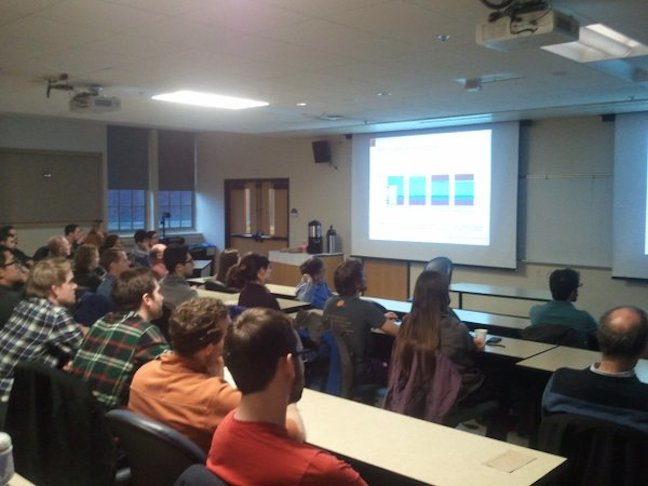
A mountain of cookies and thermoses full of coffee gave the dozens of students, faculty, and community members who gathered in Johnson Hall an energy boost as they prepared to learn about the future of the U.S. energy industry and a transition away from coal.
 The event featured Paulina Jaramillo, assistant professor of engineering and public policy at Carnegie Mellon University, and was sponsored by the UW Clean Energy Institute, which regularly puts together interactive and engaging seminars.
The event featured Paulina Jaramillo, assistant professor of engineering and public policy at Carnegie Mellon University, and was sponsored by the UW Clean Energy Institute, which regularly puts together interactive and engaging seminars.
Through a collection of graphs, including data on coal and alternative energy sources, Jaramillo came ready to discuss the future of the U.S. power system on the classroom’s medium-sized screen. The audience, especially students, was encouraged to participate and be a part of a larger discussion.
“I’ve just decided that I am going to make this an interactive lecture,” began Jaramillo.
It comes as no surprise that concerns over climate change have grown throughout the years. Coal plants are the nation’s top source of carbon dioxide emissions, the primary cause of global warming. Unfortunately, coal remains the major energy source in the U.S., generating 39 percent of the nation’s electricity.
Although coal is the cheapest fossil fuel to create electricity for lighting up our homes, offices - and anywhere else, for that matter - it’s also the dirtiest, releasing the highest levels of pollutants into the air. Coal is also the country's largest source of sulfur dioxide, a pollutant gas that causes respiratory problems, damages crops, forests and lakes.
Although coal still accounts for a majority of our electricity use, the U.S. is gradually moving toward cleaner, less polluting sources.
“Does anyone know what has led to decreases in coal,” asked Jaramillo?
Smiles and laughter fill the room. Faculty members were the first to raise their hands. Jaramillo waited for students to join in.
“Cheap, natural gas,” a student replied.
Like the UW student suggests, natural gas is becoming a popular transition fuel, creating significantly smaller environmental impacts than coal. It’s a far much cleaner fossil fuel and emits fewer greenhouse gases. However, although natural gas is a better alternative, it’s still not the answer to solving the global warming crisis. But clean energy sources like wind power might just be. Wind turbines emit zero greenhouse gases and can generate up to 20 percent of America’s electricity.
“If you transition away from coal you need something else to generate electricity, and wind power is one of those clean sources,” said Jaramillo.
Investing in clean energy technologies is becoming a way of life for many Americans. Over 29 states have increased the production of energy from renewable sources like wind, solar, biomass and other alternatives to fossil fuels. By 2030, the Clean Power Plan calls for a 30 percent increase in renewable energy production. Power plants are also required to set carbon pollution reduction coals to help reduce carbon emissions by 32 percent.
Even with clean energy technologies, it’s hard to say that our dependency on coal will diminish completely in the near future, especially considering how much electricity is derived from it.
“There are political, economic, and social constraints that will not allow us to realistically eliminate all of coal by 2030," said Jaramillo. "If we were willing to spend all the money in the world we could eliminate coal, but we have limited resources.”
She added, “(The goal) is to reduce emissions. Wind power is a way of reducing emissions.”
Whether it was discussing the environmental and health implications of coal or suggesting alternative ways to generate electricity – Jaramillo’s lecture was a true engaging classroom experience. The audience was part of the discussion, asking questions, hearing feedback, and walking away with greater understanding of America's transition away from coal. It felt like a class I would take at the UW, and a free one at that.